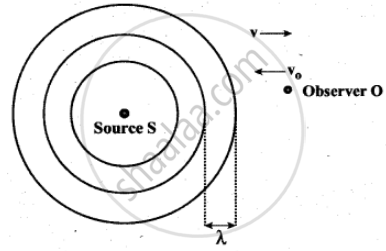Advertisements
Advertisements
प्रश्न
Discuss the following case-
Observer in motion and Source at rest.
- Observer moves towards Source
- Observer resides away from the Source
उत्तर
(a) Observer moves towards Source:

Observer moves towards Source
We can assume that the observer O moves towards the source S with velocity vo. The source S is at rest and the velocity of sound waves (with respect to the medium) produced by the source is v.
From the Figure, It is observed that both vo and v are in opposite direction. Then, their relative velocity is vr = v + vo. The wavelength of the sound wave is λ = `"v"/"f"`, which means the frequency observed by the observer O is f ‘ = `"v"_"r"/lambda`. Then
`"f"' = "v"_"r"/lambda = (("v" + "v"_0)/"v")"f"`
`= "f"(1 + "v"_0/"v")` ...(7)
(b) Observer recedes away from the Source:
If the observer O is moving away (receding away) from the source S, then velocity v0 and v move in the same direction. Hence, their relative velocity is vr = v – v0. Hence, the frequency observed by the observer O is
`"f"' = "v"_"r"/lambda = (("v" + "v"_0)/"v")"f"`
`= "f"(1 - "v"_0/"v")` ...(8)
APPEARS IN
संबंधित प्रश्न
Solve the following problem.
A police car travels towards a stationary observer at a speed of 15 m/s. The siren on the car emits a sound of frequency 250 Hz. Calculate the recorded frequency. The speed of sound is 340 m/s.
The sound emitted from the siren of an ambulance has a frequency of 1500 Hz. The speed of sound is 340 m/s. Calculate the difference in frequencies heard by a stationary observer if the ambulance initially travels towards and then away from the observer at a speed of 30 m/s.
A ship in a sea sends SONAR waves straight down into the seawater from the bottom of the ship. The signal reflects from the deep bottom bedrock and returns to the ship after 3.5 s. After the ship moves to 100 km it sends another signal which returns back after 2 s. Calculate the depth of the sea in each case and also compute the difference in height between two cases.
A railway engine whistling at a constant frequency moves with a constant speed aixi it goes past a stationary observer standing beside the railway track. Then the frequency of (n') of the sound heard by the observer with respect to time (t) can be best represented by which of the following curve?
An observer moves towards a stationary source of sound with a velocity one-fifth of the velocity of sound. The percentage increase in the apparent frequency heard by the observer will be ______.
If a star appearing yellow starts accelerating towards the earth, its colour appears to be turned ______.
A car sounding a horn of frequency 1000 Hz passes au observer. The ratio of frequencies of the horn noted by the observer before and after passing of the car is 11 : 9. If the speed of sound is 'V', the speed of the car is ______.
In a quink tube experiment, a tuning fork of frequency 300 Hz is vibrated at one end. It is observed that intensity decreases from maximum to 50% of its maximum value, as tube is moved by 6.25 cm. Velocity of sound is ______ m/s.
A train moving at 25 m/s emits a whistle of frequency 200 Hz. If the speed of sound in air is 340 m/s, find the frequency observed by a stationary observer.
- if the observer is in front of the source.
- if the observer is behind the train.
The pitch of the whistle of an engine appears to drop by 20% of its original value when it passes a stationary observer. If the speed of sound in the air is 350 m/s, then the speed of the engine (in m/s) is ______.
